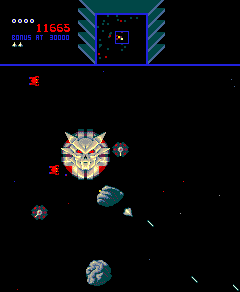Orphaned Computers & Game Systems
(Archive)
Vol. I, Issue 2 August 1994
Classic Games Reviewed!
The Best of the Best
(and Sometimes, the Worst of the Worst)
Reviews:
Jumpman, Jr., Epyx
Sinistar, Williams
Jumpman, Jr. (Epyx), Computer Game, 1983
Reviewed by Adam Trionfo
.gif)
I first played Jumpman, Jr. on the ColecoVision in about 1984. My friend could play that game without losing a man for hours. I remember when he had once recieved over one hundred fifty men. No kidding! I, on the other hand, am nowhere near as adept as that. In fact, I am unable to pass the third level on the Atari version.
I don't remember the Coleco translation well enough to say how good it was. I think it was about the same. The advantage that the Atari has is that you can use an Atari joystick, rather then the Coleco controller. I find the Coleco controllers difficult to use sometimes, especially when trying to make precise movements.
Jumpman, Jr. is a simple platform game with ten levels. You control a guy wearing rocket boots, which give him the ability to jump from platform to platform. The object is to collect all the clover-shaped objects, which are bombs, without losing all your men. (Not quite original, but at least you don't have to save the world!)
(Level_1).gif)
There is no time limit, but there are many obstacles that would be glad to help you get rid of your lives. There are bullets that travel slowly at first, speeding up when they spot you. There are pits that you can fall into, especially on the higher levels, where the screen is black and you cannot see where you are going. There may be missiles, too, as there are some in the first Jumpman game, but I am not sure if this one contains any.
There are other obstacles that make the game more complicated, but which are not really out to get you. There are two types of ropes, one of which your Jumpman climbs automatically when he has jumped onto it. He lowers himself down the other type of rope. There are ladders, too, which connect the levels.
Overall, Jumpman, Jr. is simple to play, and responds quickly to the joystick movements. I find it highly addictive, and usually play for nearly an hour at a time. (For me, an hour of playing the same game is a long time!)
Sinistar (Williams), Arcade Game, 1982
Reviewed by Dave Wesner

If you're reading this mag at all, you've probably got a healthy sense of video-game nostalgia. I do, and if you're like me, much of this nostalgia centers around not only the games you used to play at home, but on those old arcade games as well.
Maybe it's just the impending old age (I'm 26), but it seems that there is something special about those older arcade games. Most had no music, or maybe six or seven notes that were repeated endlessly. (Remember Xevious?) You didn't beat games then, either. If you had the skill and the will, you could literally play all day on one quarter.
Graphics were limited, too, so the programmers had to compensate with big doses of creativity. Now games can be made to resemble whatever the programmers want them to. As a result, they seem to lack somewhat in really innovative ideas. Also, doesn't it seem like all the good ideas have been taken?
As I write this, there is an old Sinistar machine looking over my shoulder. This game is a great example of the "classic arcade" genre. Most people who try it will fail miserably, because it's not immediately obvious what you have to do.
You pilot a small, triangular ship, which is kind of a raster-graphic update on the ship in Asteroids. You still fly through asteroid fields, but these scroll in any direction you choose. You must shoot the asteroids, which release "crystals." Each crystal, basically a flashing pixel, gives you one "sinibomb."
While you are collecting the crystals, there are little, red, bug-like creatures ("workers") that swarm around you, trying to pick up stray crystals. The workers' mission in life is to build Sinistar out of the crystals. Sinistar is a giant, spiky, white face that, when completed, chases you relentlessly, shouting harangues like, "Run, coward!" and "I hunger!".
To make matters worse, while the workers are building Sinistar, round, tank-like "warriors" take potshots at you, with varying degrees of accuracy.
The purpose of the game is to destroy Sinistar. To do this, launch sinibombs at him. It takes at least thirteen of these to smash Sinistar, so you must mine the asteroids diligently while ol' Sinnie's getting built. Otherwise, you'll end up spinning into that grinning mouth, amid derisive laughter. Once the Sinistar consumes you, he gives you the helpful reminder, "I am Sinistar."
Typical of games made by Williams in its heyday, this is not an easy play. There are no patterns guaranteed to work, so concentration and reflexes are your only hopes. After each Sinistar is destroyed, you progress to a new "zone." Each is named for, and has a greater proportion of, either warriors, workers or asteroids. There is also a "void" zone, containing few of any of these obstacles. The game doesn't end; you just keep shuttling from zone to zone until your ships run out.
Sinistar wasn't one of Williams's big hits, but it stands up today at least as well as Robotron: 2084, Joust or Defender. The machine behind me is set to give ten ships for a quarter, so I've been indulging my high-school nostalgia quite a bit lately. It brings it all back: sitting in class and waiting for that final bell, so I could bolt to the Cosmos game room, or maybe the Cave Inn, hurried by that voice in my head, screaming "Run, coward!".